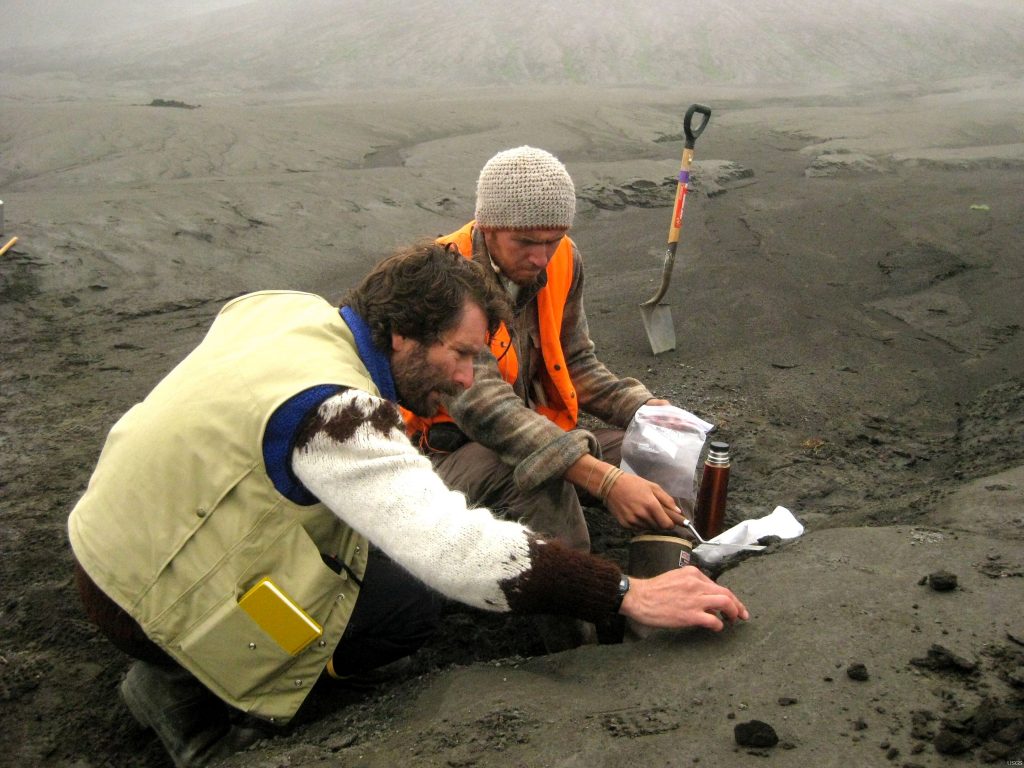By Julie Hammonds
Office of the Vice President for Research
An extremely explosive volcanic eruption on the Italian peninsula 39,000 years ago is the subject of a new study by professor Michael Ort of Northern Arizona University’s School of Earth and Sustainability. The National Science Foundation recently awarded Ort $290,000 for the three-year project.
Through careful fieldwork and advanced geochemical analysis, Ort will unlock the secrets of the Campanian Ignimbrite super-eruption. Ort, who’s been studying this volcanic event for years, believes it may show why some eruptions are so explosive.
“It was the largest eruption in at least the past few hundred thousand years in Europe and was perhaps several hundred times bigger than the Mount St. Helens eruption in 1980,” Ort said.
From a volcanic vent in what is now Naples, ash spread far to the east. The explosion left its signature all over the eastern Mediterranean and eastern Europe—even as far away as Moscow.
“Many archaeologists think the eruption delayed the migration of modern humans, allowing Neanderthals to last a bit longer in Spain,” Ort said.
An unusual pyroclastic flow raced along, then soared aloft
Two characteristics of this particular volcanic event fascinate Ort, who specializes in understanding pyroclastic currents—fast-moving currents of hot gas and volcanic matter—and magmatic processes in the Earth’s crust, such as melting and crystallization.
“First, flows more than a thousand yards deep traveled almost 50 miles, up and over ridges a mile high, even though the vent was at sea level,” he said. “That required astounding velocity and momentum. In other words, this thing moved really fast—much faster than most pyroclastic currents—so it must have had tremendous energy.”
The swift-moving current of molten rock lost material as it raced along, eventually becoming lighter than air. That sent it shooting skyward.
“Lofting into the air for a bit is not that uncommon at the end of the runout of a pyroclastic current,” Ort said. “But typically, they might go up a mile or two, and the deposits might represent 10 percent of the total volume. This current shot up into the stratosphere, forming a column modeled at 23 miles high. And its fallout was astounding—about twice the volume of the ignimbrite itself. This makes its lofting behavior much more important than in most eruptions.”
What caused the current to super-expand?
Ort is collaborating with scientists at the University of Oxford in Britain and Italy’s Università di Roma Tre and Osservatorio Vesuviano to figure out the source of the gas that enabled these unusual behaviors.
“We know this flow was very hot. What we’re looking for is the source of the gas that caused it to super-expand,” he said. “It can’t be seawater or air—these would have cooled it too much. We think it might be superheated hydrothermal fluids from the system under the caldera.”
The scientists have completed their initial field work and sample collection. Later this year, they will start testing analysis methods. The main field campaign will follow in spring 2019. Even at this stage, however, the results are intriguing.
“Within the ignimbrite rock emplaced by the volcano, we’re finding many different types of magma (present as pumice chunks now) that seem to be from different periods during the eruption,” Ort said.
The team will map those periods and assess tiny “melt inclusions” in crystals to find out how much water, carbon dioxide and other gases were present at each stage of crystallization.
“Chemical analysis will enable us to link ignimbrite far from the vent with particular layers close to the vent,” Ort said. “And we’ll look at the metamorphic reactions in limestone chunks in the ignimbrite to determine the composition of very hot fluids, possibly erupted from the hydrothermal system under the volcano, that moved through the deposit right after deposition.”
Volcanoes provide “raw materials for life”
To Ort, the point of this project is not just to understand what happened during one particular eruption 39,000 years ago.
“I think volcanoes are the most vibrant geologic process—we can see the Earth changing in seconds,” he said. “They also provide our water, air, soil and pretty much everything else on Earth’s surface. We think of them as destructive, but they are very important in creation, too; they provide the raw materials for life.”
At NAU, Ort’s primary research focus is on volcanoes, including eruption and emplacement processes, petrology, geochemistry and the interactions of humans with volcanoes. His research into eruption and emplacement processes of pyroclastic flows and surges has focused on large-volume ignimbrites in Argentina and Italy and on maar and scoria-cone volcanoes in Arizona—including the San Francisco Peaks—as well as in Alaska and Mexico.



